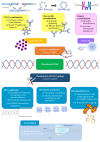Physiological Roles of DNA Double-Strand Breaks
- PMID: 29181194
- PMCID: PMC5664317
- DOI: 10.1155/2017/6439169
Physiological Roles of DNA Double-Strand Breaks
Abstract
Genomic integrity is constantly threatened by sources of DNA damage, internal and external alike. Among the most cytotoxic lesions is the DNA double-strand break (DSB) which arises from the cleavage of both strands of the double helix. Cells boast a considerable set of defences to both prevent and repair these breaks and drugs which derail these processes represent an important category of anticancer therapeutics. And yet, bizarrely, cells deploy this very machinery for the intentional and calculated disruption of genomic integrity, harnessing potentially destructive DSBs in delicate genetic transactions. Under tight spatiotemporal regulation, DSBs serve as a tool for genetic modification, widely used across cellular biology to generate diverse functionalities, ranging from the fundamental upkeep of DNA replication, transcription, and the chromatin landscape to the diversification of immunity and the germline. Growing evidence points to a role of aberrant DSB physiology in human disease and an understanding of these processes may both inform the design of new therapeutic strategies and reduce off-target effects of existing drugs. Here, we review the wide-ranging roles of physiological DSBs and the emerging network of their multilateral regulation to consider how the cell is able to harness DNA breaks as a critical biochemical tool.
Figures
Similar articles
-
Endogenous DNA Double-Strand Breaks during DNA Transactions: Emerging Insights and Methods for Genome-Wide Profiling.Genes (Basel). 2018 Dec 14;9(12):632. doi: 10.3390/genes9120632. Genes (Basel). 2018. PMID: 30558210 Free PMC article. Review.
-
Kinesin Kif2C in regulation of DNA double strand break dynamics and repair.Elife. 2020 Jan 17;9:e53402. doi: 10.7554/eLife.53402. Elife. 2020. PMID: 31951198 Free PMC article.
-
END-seq: An Unbiased, High-Resolution, and Genome-Wide Approach to Map DNA Double-Strand Breaks and Resection in Human Cells.Methods Mol Biol. 2021;2153:9-31. doi: 10.1007/978-1-0716-0644-5_2. Methods Mol Biol. 2021. PMID: 32840769
-
Removal of heat-sensitive clustered damaged DNA sites is independent of double-strand break repair.PLoS One. 2018 Dec 28;13(12):e0209594. doi: 10.1371/journal.pone.0209594. eCollection 2018. PLoS One. 2018. PMID: 30592737 Free PMC article.
-
Regulation of Histone Ubiquitination in Response to DNA Double Strand Breaks.Cells. 2020 Jul 16;9(7):1699. doi: 10.3390/cells9071699. Cells. 2020. PMID: 32708614 Free PMC article. Review.
Cited by
-
Editorial: DNA damage response in the context of chromatin.Front Cell Dev Biol. 2023 Jan 10;10:1095652. doi: 10.3389/fcell.2022.1095652. eCollection 2022. Front Cell Dev Biol. 2023. PMID: 36704204 Free PMC article. No abstract available.
-
A Novel Spo11 Homologue Functions as a Positive Regulator in Cyst Differentiation in Giardia lamblia.Int J Mol Sci. 2021 Nov 2;22(21):11902. doi: 10.3390/ijms222111902. Int J Mol Sci. 2021. PMID: 34769330 Free PMC article.
-
USP52 regulates DNA end resection and chemosensitivity through removing inhibitory ubiquitination from CtIP.Nat Commun. 2020 Oct 23;11(1):5362. doi: 10.1038/s41467-020-19202-0. Nat Commun. 2020. PMID: 33097710 Free PMC article.
-
Deficiency in homologous recombination is associated with changes in cell cycling and morphology in Saccharomyces cerevisiae.Exp Cell Res. 2023 Sep 1;430(1):113701. doi: 10.1016/j.yexcr.2023.113701. Epub 2023 Jun 30. Exp Cell Res. 2023. PMID: 37393982 Free PMC article.
-
Archaeal DNA Repair Mechanisms.Biomolecules. 2020 Oct 23;10(11):1472. doi: 10.3390/biom10111472. Biomolecules. 2020. PMID: 33113933 Free PMC article. Review.
References
Publication types
LinkOut - more resources
Full Text Sources
Other Literature Sources


